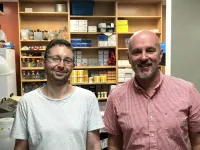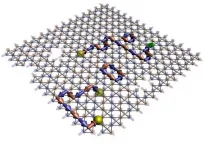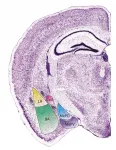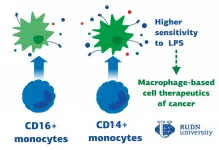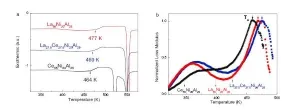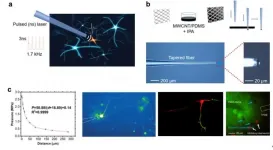INFORMATION:
The work was funded primarily by the Canadian Institutes of Health Research (CIHR), the Cancer Research Society, and the Krembil Foundation.
New Sinai Health research finds common denominator linking all cancers
2021-07-16
(Press-News.org) All cancers fall into just two categories, according to new research from scientists at Sinai Health, in findings that could provide a new strategy for treating the most aggressive and untreatable forms of the disease.
In new research out this month in Cancer Cell, scientists at the Lunenfeld-Tanenbaum Research Institute (LTRI), part of Sinai Health, divide all cancers into two groups, based on the presence or absence of a protein called the Yes-associated protein, or YAP.
Rod Bremner, senior scientist at the LTRI, said they have determined that all cancers are present with YAP either on or off, and each classification exhibits different drug sensitivities or resistance. YAP plays an important role in the formation of malignant tumours because it is an important regulator and effector of the Hippo signaling pathway.
"Not only is YAP either off or on, but it has opposite pro- or anti-cancer effects in either context," Bremner said. "Thus, YAPon cancers need YAP to grow and survive. In contrast, YAPoff cancers stop growing when we switch on YAP."
Many YAPoff cancers are highly lethal. In their new research, Bremner and fellow researchers from the Roswell Park Comprehensive Cancer Center in Buffalo, NY, show that some cancers like prostate and lung can jump from a YAPon state to a YAPoff state to resist therapeutics.
When cancer cells are grown in a dish in a lab setting, they either float or stick down. The team of researchers found that YAP is the master regulator of a cell's buoyancy, where all the floating cells are YAPoff, and all the sticky cells are YAPon. Changes in adhesive behavior are well known to be associated with drug resistance, so their findings implicates YAP at the hub of this switch, explained Bremner.
Joel Pearson, co-lead author and a post-doctoral fellow in the Bremner Lab at the LTRI, said therapies that tackle these cancers could have a profound effect on patient survival.
"The simple binary rule we uncovered may expose strategies to treat many cancer types that fall into either the YAPoff or YAPon superclasses," Pearson said. "Moreover, since cancers jump states to evade therapy, having ways to treat either the YAPoff and YAPon state could become a general approach to stop this cancer from switching types to resist drug treatments."
The researchers hope by deducing common vulnerabilities of these types of cancer, it may be possible to develop new therapeutic approaches and improve patient outcomes.
ELSE PRESS RELEASES FROM THIS DATE:
NIH-funded study finds gene therapy may restore missing enzyme in rare disease
2021-07-16
WHAT:
A new study published in Nature Communications suggests that gene therapy delivered into the brain may be safe and effective in treating aromatic L-amino acid decarboxylase (AADC) deficiency. AADC deficiency is a rare neurological disorder that develops in infancy and leads to near absent levels of certain brain chemicals, serotonin and dopamine, that are critical for movement, behavior, and sleep. Children with the disorder have severe developmental, mood dysfunction including irritability, and motor disabilities including problems with talking ...
Emergent magnetic monopoles isolated using quantum-annealing computer
2021-07-16
LOS ALAMOS, N.M., July 15, 2021-- Using a D-Wave quantum-annealing computer as a testbed, scientists at Los Alamos National Laboratory have shown that it is possible to isolate so-called emergent magnetic monopoles, a class of quasiparticles, creating a new approach to developing "materials by design."
"We wanted to study emergent magnetic monopoles by exploiting the collective dynamics of qubits," said Cristiano Nisoli, a lead Los Alamos author of the study. "Magnetic monopoles, as elementary particles with only one magnetic pole, have been hypothesized by many, and famously by Dirac, but have proved elusive so far."
They realized an artificial spin ice by using the superconducting qubits of the quantum machine as a magnetic building block. Generating magnetic materials ...
Watching the ultrafast dance moves of a laser plasma
2021-07-16
Great leaps in science and technology have been propelled by recent advances in seeing fast evolving physical phenomena, as they happen. Femtosecond lasers from the infrared to the X-ray region have enabled us to 'watch', in real time, atoms dance in molecules and solids on femtosecond and picosecond timescales. Watching such fascinating motions not just in real time but at the spatial locations where they happen, is a bigger challenge.
It is precisely this advance that has been made by a team of researchers at the Tata Institute of Fundamental Research, Mumbai, York University and the Rutherford Appleton Laboratories, UK [1]. They exploded a solid surface with an ultrahigh ...
How micro-circuits in the brain regulate fear
2021-07-16
Fear is an important reaction that warns and protects us from danger. But when fear responses are out of control, this can lead to persistent fears and anxiety disorders. In Europe, about 15 percent of the population is affected by anxiety disorders. Existing therapies remain largely unspecific or are not generally effective, because the detailed neurobiological understanding of these disorders is lacking.
What was known so far is that distinct nerve cells interact together to regulate fear responses by promoting or suppressing them. Different circuits of nerve cells are involved in this process. A kind of "tug-of-war" takes place, with one brain circuit ...
The paradox of a free-electron laser without the laser
2021-07-16
A new way of producing coherent light in the ultra-violet spectral region, which points the way to developing brilliant table-top x-ray sources, has been produced in research led at the University of Strathclyde.
The scientists have developed a type of ultra-short wavelength coherent light source that does not require laser action to produce coherence. Common electron-beam based light sources, known as fourth-generation light sources, are based on the free-electron laser (FEL), which uses an undulator to convert electron beam energy into X-rays.
Coherent light sources are powerful tools that enable research in many areas of medicine, biology, material sciences, chemistry and physics.
This new way of producing coherent radiation could revolutionise light sources, as it would ...
New optimisation method for computational design of industrial applications
2021-07-16
In the field of industrial engineering, using simulations to model, predict and even optimise the response of a system or device is widespread, as it is less expensive and less complex -and, sometimes, less dangerous- than fabricating and testing several prototypes.
This type of simulation studies uses numerical methods that, depending on the problem to be addressed -for example, reducing the aerodynamic forces of an aircraft by changing its shape or using the minimum possible amount of material on elements under loading without breaking- require the simulation of a wide variety of possible combinational cases, which entails high computational costs.
The researchers from the School of Industrial Engineering of the University of Malaga Francisco Javier Granados Ortiz ...
Neuro-evolutionary robotics: A gap between simulation and reality
2021-07-16
Neuro-evolutionary robotics is an attractive approach to realize collective behaviors for swarms of robots. Despite the large number of studies that have been devoted to it and although many methods and ideas have been proposed, empirical evaluations and comparative analyses are rare.
A publication in the journal Nature Communications, led by Mauro Birattari and his team at the research center IRIDIA, École Polytechnique de Bruxelles, Université Libre de Bruxelles, compares some of the most popular and advanced neuro-evolutionary methods for offline design of robot swarms.
"Concretely, these ...
RUDN University biologists prove the anticancer potential of macrophages
2021-07-16
RUDN University biologists discovered the way how macrophages (the cells of the "first line" immune response) respond to inflammation and identified how the immune response depends on their origin. It turned out that when exposed to an inflammatory stimulus, two opposing mechanisms are activated in macrophages simultaneously -- inducing and inhibiting inflammation. These data can potentially be useful in the treatment of cancer, as targeted activation of macrophages will strengthen the immune response of the organism in the fight against a tumor. The results were published in the journal Biomedicine & Pharmacotherapy.
Macrophages are the cells responsible for phagocytosis -- they capture bacteria, the dead cells remains ...
New discoveries and insights into the glass transition
2021-07-16
A collaborative group from Tohoku University and Johns Hopkins University have provided valuable insights into the glass transition.
When a liquid is cooled rapidly, it gains viscosity and eventually becomes a rigid solid glass. The point at which it does so is known as the glass transition.
But the exact physics behind the glass transition, and the nature of glass in general, still pose many questions for scientists.
Metallic Glasses (MGs) are highly sought after since they combine the flexibility of plastic with the strength of steel. They are amorphous materials with a disordered atomic structure and exhibit unique and divergent thermodynamic ...
Non-genetic photoacoustic stimulation of single neurons by a tapered fiber optoacoustic emitter
2021-07-16
Neuromodulation at high spatial resolution has been an invaluable approach for treating neurological diseases and advancing fundamental knowledge in the field of neuroscience, as firing of a small population or even single neurons can specifically alter animal behavior or brain state. Optogenetics is a powerful method capable of modulating population neural activity in rodents, yet its requirement for viral transfection limits its applications in nonhuman primates and humans. As a rapidly growing modality, focused ultrasound has been harnessed in a myriad of brain neuromodulation applications. However, conventional piezo-based transducers offer a spatial resolution of several millimeters. It is also challenging ...
